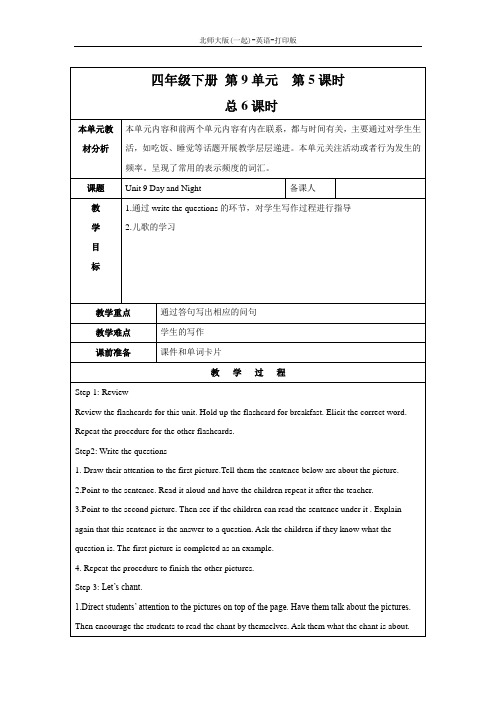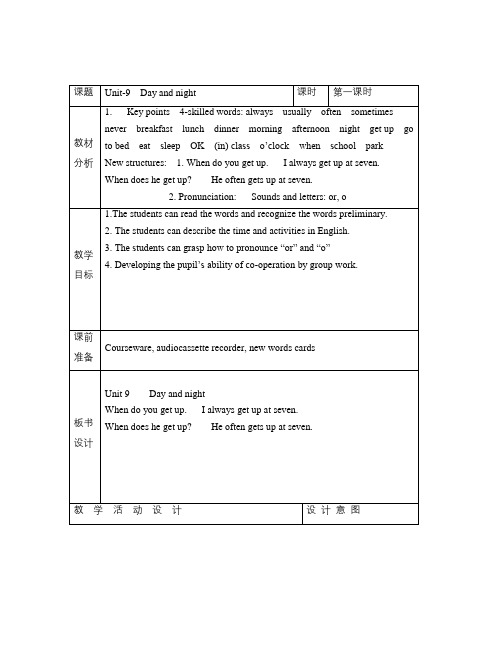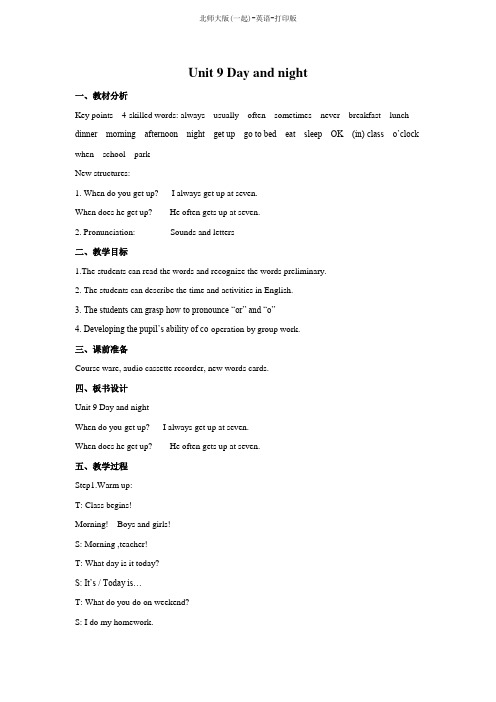2019年春学期小学英语(北师大版)四年级下册《unit 9 Day and night》word版教案 (1)
- 格式:doc
- 大小:46.00 KB
- 文档页数:5

北师大小学英语一起点Unit-9 Day and night课时第五课时四年级英语知识需要巩固背诵单词和课文不要粗心大意。
北师大小学英语一年级起点伴成长快乐学习!课题教材分析1. Key points 4-skilled words: always usually often sometimes never breakfast lunch dinner morning afternoon night get up go to bed eat sleep OK (in) class o’clock when school parkNew structures: 1. When do you get up. I always get up at seven.When does he get up? He often gets up at seven.2. Pronunciation: Sounds and letters: or, o教学目标1.The students can read the words and recognize the words preliminary.2. The students can describe the time and activities in English.3. The students can grasp how to pronounce “or” and “o”4. Developing the pupil’s ability of co-operation by group work.课前准备Courseware, audiocassette recorder, new words cards板书设计Unit 9 Day and nightWhen do you get up. I always get up at seven. When does he get up? He often gets up at seven.教学活动设计设计意图Step1. Warm up:T: Class begins!Morning! Boys and girls!S: Morning ,teacher!T: What day is it today?S: It’s / Today is…T: What do you do on weekend? Practise the students’ listeningAnd speakingS: I do my homework.Step 2. Review1. Review the following vocabulary: always, usually, often, sometimes, and never. Write the words on theboard and check that the children can remember their different meanings.2. Now review the phrases get up, go to bed, eat breakfast / lunch / dinner, and the word sleep.3. Repeat the procedure used to review the other words.4. Point to the word always. Say, “I always get up at ( seven ) o’clock.” have a child in the class give you another example sentence. Make sure that the child uses the word always and one of the other activities written on the board, for example, I always eat lunch at 12 o’clock.5. Repeat the procedure for usually, often, sometimes, and never.Step 3. Touch, ask, and answer1. Have the children open their books at page 33. Draw their attention to the bottom of the page. Show your copy of the page. Point to the Tommy and Ken. say, “What is Tommy saying?” See if the children can read the question without your help. Now read the words together.2. Repeat the procedure for Ken’s answer.3. Now point to the picture of the first clock. Ask, “What time is it?” Elicit, “It’s one o’clock."4. Repeat the procedure for the other two pictures below the clock. Ask the children to know the new languages of this unit.Elicit the new words Practise the new sentences.Raise the students using the sentences ability5. Point to the picture of Ken getting up. Ask, “What is Ken doing?” Elicit, “He is getting up.”6. Repeat for the other two pictures ( Ken is going to school, and Ken is eating lunch.).7. Point to the picture of the notepad. See if the children can read the words to you. Then read the words together.8. Put the children into pairs to practice the question and answers. Encourage them to use all possible combinations.Step 4. Write the questions1. Have the children open their books at page 34. Show your copy of the page. Explain that you will read the sentences together.2. Point to the first picture. Then see if the children can read the sentence under it. You may need to help them. Read the sentence together. Explain to thechildren that this sentence is the answer to a question..3. Now point to the completed example above the picture. Explain to the children that this is the question to which “Mocky always eats breakfast in the morning.” Is the answer.4. Point to the second picture. Then see if the children can read the sentence under it. Explain again that this sentence is the answer to a question. Ask the children if they know what the question is.5. Now have the children write the question on the line above the picture.6. Repeat the procedure for the other pictures and sentences. Consolidate the new words and the new sentences.Step 5. Let’s chantTell the children that we are going to learn a chant. Have the children open their books and look at the pictures at the top of this page.1. Point to the pictures and ask questions. Have children talk about the pictures.2. Now read the first four lines aloud to the children, pointing each word as you do so. Have children repeat after you.3. Play the tape for the first four lines. Have the children listen to the chant.4. Play the tape again, stopping after each sentence. Have the children repeat after the tape.5. Now play the tape without stopping this time. Have the children say the chant in a class drill following the tape.Step 7. extendHave the children make a new chant like this text. Step 8. Sum up: Ask the children to know the new languages of this unit and at the same time, consolidate the key point for this unit.作业设计Must do:1. Read the new text 5 times at home.2. Translate the text into Chinese.3. Preview page 32,35Choosing do:Make a new chant by yourself.教学反思All of the children have finished the exercises.相信自己,就能走向成功的第一步教师不光要传授知识,还要告诉学生学会生活。



Unit 9 Day and night 教学设计教学目标1、学生能够掌握字母or和oor在单词中的发音,并能完成练习;2、能熟练掌握小黑板关于使用频率词汇的句型,并能运用always、usually、often、sometimes、never回答有关于日常生活规律的问题;3、能运用频率词汇说一说自己的日常生活。
学情分析本节课的教学对象是我校四年级的学生,学生整体情况如下:1、大多数学生对英语学习有浓厚的兴趣,喜欢听英语、说英语,乐于用英语交流,思维活跃,善于模仿;2、学生经过将近四年的英语学习,已经能够感知单词的发音规律并能在一定的引导下总结发音规律;3、经过前三个课时的学习,学生已经能够初步掌握表示频率的词汇的用法,并能尝试初步运用;4、仍有少数学生对用英语进行表达感觉吃力,有畏难情绪;or和oor的发音对于学困生来说不易掌握。
重点难点1、学生能够掌握字母or和oor在单词中的发音;2、能运用always、usually、often、sometimes、neve说一说自己的日常生活。
教学过程【导入】Warm-upSing a song~BINGOIntroduce Little Jack.T:Just now we sang a song about a farmer.Look,this is Little Jack.He is a farmer,too.Let’s say Hello to him.【讲授】Presentation1.Visit Little Jack’s house结合图片首次感知语音词汇;T:Oh,this is Jack’s house. There are many things on the floor.What are they?2.Help Little JackT:It’s not clean.Let’s clean them up.Where can we put them?3.Chant1)Listen to the ChantT:Oh,now his room is very clean so he is very happy.Listen!He is chanting for you.2)Look and say(Show the chant.)3)Practice in groups4)Show the chant5)Chant with Little JackT:Who wants to chant with Little Jack?You can stand up.4.Present the words(以文字的形式呈现语音词汇)【练习】Practice OneI.Learning1、Try to readT:Good!You did very well.Can you read these words?2、Listen and readT:Now let’s read follow the computer and pay attention to these red letters.3、Try to find the rulesT:Great!What do you find?(引导学生说出字母o和or/oor的发音规律)II. Rules4、Say out the wordsT:Can you try to read these words?板书:o or/oorg o t l or dd o t m or e... ...5、Say more words like theseT:Can you say any words like these?III. Practicing6、Task One~Cross the riverT:Good!Oh,you know so many words now.Can you help Jack?He wants to cross the river.But some parts of the woods are broken.Can you find and cross them?Now do it in groups.7、Task Two~Pick up some mushroomsT:Now Jack can cross the river.Can you guess what will he do?T:Oh,he wants to pick some mushrooms.And look there are many mushrooms and there are two baskets.Can you put them into the right basket?Do it in groups.T:Which group wants to show your baskets?【练习】Practice TwoI. Let's learn1.Play a Game~Words poolT:Little Jack is very happy.It’s dinner time.He wants to wash the mushrooms in the water.Look!Here’s the pool.Oh,it’s a words you want to play a game?T:I will point some words and these words can make a sentence.When I stop,you should say out the sentence as quickly as you can.(教师指出句子)2.Read Uncle Booky’s BlackboardT:Oh,there are many sentences in this pool but wait a minute let’s read them first.3.Read Uncle Booky’s Blackboard.4.Play the Game.(学生指句子)T:Now,it’s your turn.Who wants to point a sentence for us?II. Let's say1.GuessingT:Oh,Little Jack not only picks the mushrooms every day.He also has many things to do.Can yo u guess what things he does every day?2.Ask and answera.T:Let’s see what things he does every day.(呈现图片)b.T:Do you want to know when he does these things?Let’s ask him.板书:When do you...?Let’s listen.板书:I always...3.Order the words.【活动】Extension1.Touch and SayT:Now we know when Little Jack does these things.Do you remember our friend Ken?(出示PPT)a.Guessing what are they talking aboutT:Oh,he is talking with his friend.What are they talking?S:They are talking about the time.T:Yes,let’s read it together.b.Ask and answer in pairsT:Please open your books.Turn to Page33.Look at these pictures.And try to ask and answer in i s Ken and another one is his friend.T:When does Ken...?板书:When does...?He usually...c.Show the dialogue.2.Read about Ken’s daily lifeT:Oh!This is Ken’s daily life.Read it in your groups.3.Say something about your life.T:Listen!What did he say?(播放Ken的录音)T:Can you talk with your partner?And you can use these phrases or what other things you want to say.【作业】Homework1)Practice the pronunciation;2)Try to write about your daily life。

Unit 9 Day and night一、教材分析Key points 4-skilled words: always usually often sometimes never breakfast lunch dinner morning afternoon night get up go to bed eat sleep OK (in) class o’clock when school parkNew structures:1. When do you get up? I always get up at seven.When does he get up? He often gets up at seven.2. Pronunciation: Sounds and letters二、教学目标1.The students can read the words and recognize the words preliminary.2. The students can describe the time and activities in English.3. The students can grasp how to pronounce “or” and “o”4. Developing the pupil’s ability of co-operation by group work.三、课前准备Course ware, audio cassette recorder, new words cards.四、板书设计Unit 9 Day and nightWhen do you get up? I always get up at seven.When does he get up? He often gets up at seven.五、教学过程Step1.Warm up:T: Class begins!Morning! Boys and girls!S: Morning ,teacher!T: What day is it today?S: It’s / Today is…T: What do you do on weekend?S: I do my homework.Step 2. Review1.Review the flashcards for this Unit. Hold up the flashcard for morning and elicit the correct word.2.Repeat the procedure for afternoon, night, breakfast, lunch, and dinner.Step 3. Words to learn1.Have the children open their b ooks at page 28. Direct the children’s attention to t he top half of the page. As you play the tape, have them touch the matching words or pictures.2.Replay the tape while showing your copy of the page. Stop the tape after each word and have the children repeat the words.3.Play the tape again without stopping. Have the children say the words along with the tape.4.Without playing the tape, point to one of the pictures or word from the children.5.Repeat the procedure for all the other pictures and words.Step 4. Uncle Booky’s Blackboard1.Have the children open their books at page 33. Model the s tructures on Uncle Booky’s Blackboard by reading them aloud to the class.2. Have the children repeat the structures in a class drill. Use all possible combinations.Step 5. Pair work:Ask the students to talk about the time and the activities with their schedule. And then make a new dialogue and act it out.Step 9. Fight game:The students have five minutes to prepare the competition.Game 1: Please say out the new words in Chinese.Game 2: Please say out the new words in English.Game 3: Please find out the next sentence.Step 10. Extend:The third personal and singular form in the present sense.Step 11. Sum up:Today we have learned the third personal and singular form in the present sense.Practice th e students’ listeningAnd speakingAsk the children to know the new languages of this unit. Elicit the new wordsPractice the new sentences.Raise the students using the sentences ability六、作业布置Must do:1. Read the new words 5 times2. Copy the new words 4E 1C3. Copy the new structures 2E 1C4. Recite the new words and the new structures. Choosing do:Make a new dialogue.教学反思The children have grasped the words of week, the other words and phrases need be consolidated by the children.。

Unit 9 Day and night.教案教学目标:1.学生能够认读、听辨、默写Words to learn 中的个单词;2.能够认读、听辨单词表中相关词汇;3.学生能够听辨、认读并使用功能句型4.能够认读、听辨字母组合的发音;5.能够整体感知text,能力水平较高的学生能够表演;6.能够独立完成阅读;7.能感知story time,能力水平较高的学生能够表演8.能够说唱歌谣,并理解其含义。
教学重点:1.表示一天的时间单词,频率副词2.重点句型的掌握When do you ________?I always ________.When does he/she_____?He/she usually ______.3.difficult points :sounds and letters教学步骤:Step 1 Warm-up and revisionPlay a chantListen and do the actions(Reading drinking eating running sleeping jumping cooking washing painting)Step 2 presentation and drillsT: You do very well. You do the actions during the diary routine. Do you want to know other people’s diary routine. Now let’s watch the vi deo and find out Uncle Booky”s diary r outine.1. Play the video and let them think about the following questions. What is Mocky doing at the beginning of the story?What is Uncle Booky doing at the end of the story?What is Lulu doing?2. Mow let them answer the questions3. T: Can you find out What activity that Mocky, Ann and Uncle Booky do in the story?Read the story carefully and underline them on the book.4. Show the course ware5. T: How often do they do the things?Discuss the questions and find out the correct words to fill in the blanks to complete the sentences. All the sentences are in the story.6. Play the course wareShow the adverb frequent wordsAlways usually often sometimes neverStep 3 practice1. Play the course ware and let them make the sentences2. Play the tape and let them repeat it3. Ask and answerT: When do you get up?Students:T: Do you always get up in the morning?Students:T: What about your mother?When does she get up?Does she always get up in the morning?Students:Step 4 consolidation1. Play the tape and repeat the dialog one sentences by one.2. Show three sentences and let them understand their differentI sleep at night.She is sleeping.单靠“死”记还不行,还得“活”用,姑且称之为“先死后活”吧。
Unit-9 Day and night教材分析1. Key points 4-skilled words: always usually often sometimes never breakfast lunch dinner morning afternoon night get up go to bed eat sleep OK (in) class o’clock when school parkNew structures: 1. When do you get up. I always get up at seven. When does he get up? He often gets up at seven.2. Pronunciation: Sounds and letters: or, o教学目标1.The students can read the words and recognize the words preliminary.2. The students can describe the time and activities in English.3. The students can grasp how to pronounce “or” and “o”4. Developing the pupil’s ability of co-operation by group work.课前准备Courseware, audiocassette recorder, new words cards板书设计Unit 9 Day and nightWhen do you get up. I always get up at seven. When does he get up? He often gets up at seven.教学活动设计设计意图Step1. Warm up:T: Class begins!Morning! Boys and girls!S: Morning ,teacher!T: What day is it today?S: It’s / Today is…T: What do you do on weekend?S: I do my homework.Step 2. Reviewe the following game to review the structures “What are you doing?”, “I’m (shopping).” (the child pretends to do the action), “ (He) is (swimming).”, and some of the core vocabulary introduced in earlier books (playing, reading, cooking, drinking, eating, sleeping, washing, and painting).2. Divide the class into two teams. Have the child from one teams come to the front of the class. Whisper a word to the child. The child’s team should then ask, “What are you doing?” In response, the child should say, “I’m…” and then pretend to do the action of the word.3. The child’s team scores a point if they can remember the English name for the action. For example, if a child pretends to be sleeping, his or her team should say, “(She) is sleeping.”4. Repeat the procedure with a child from the other team.5. Continue the game until most of the children have had a turn. “The team that scores the most points is the winner.Step 3. Set the scene1.In Chinese, ask the children what they do immediately after they wake up in the morning on Practise the students’ listeni ng And speakingAsk the children to know the new languages of this unit.a weekday. Ask, “Do you (get up)?”2. Present the word always. Write the word on the board and explain its meaning. point to the word and model it for the children. Have them repeat it after you.3. Now ask one of the children what he or she does after school. After the child has answered, ask, “Do you always ( play with your friends ) after school?”4.Present the word usually. Repeat the procedureused for always.5. Ask another child what he or she does on Sunday. Then present the words often and sometimes. Repeat the procedure used for always.6. Ask the children, “Do you ever eat breakfast at night?” After the children have answered, present the word never.Step 4. Model the dialog1. Present the flashcard for morning. Explain the meaning of the word. Model the word and have the children repeat it after you.2. Repeat the procedure for the other flashcards ( afternoon, night, breakfast, lunch, and dinner ).3.Present the question, “When do you eat breakfast?” Write the question on the board and explain its meaning to the children. Read the question aloud, pointing to the words as you do so. Have the children repeat the question after you.4.Ask the children, “When do you eat breakfast?” Try to elicit, “In the morning.” Present the structure, “I always eat breakfast in the morning.” Repeat the procedure used to Elicit the new wordsPractise the new sentences.model the question.Step 5. Talk about the storyHave the children open their books at pages 26 and 27. Then ask these questions about the pictures:P1: “What is Mocky doing?”(Point to the picture of the watch. Ask, “What time is it?” Elicit, “It’s three o’clock.”)P2: “What is happening now?”P3: “What is Lulu doing?”P4 / 5 / 6: “What is happening now?”P7 : “Can you guess where Ann, Ken, and Mocky aregoing?”( See if the children can read Uncle Booky’s name. )P 8 / 9: “Where do you think they are now?”P10: “What is Uncle Booky doing?”Step 6. Story1. Say, “Now we’re going to hear what the characters said.” Play the tape without stopping. Have the children look at the pictures as they listen.2. Play the tape again, pointing to each picture. Pausing after each picture. Have the children repeat the words each time.Step 7. Pair work:Ask the students to talk about the time and the activities with their friends . And then act it out.Step 8. Group work:Ask the students to make a new dialogue in their groups. And then act it out.Step 9. Fight game: Elicit the new sentencesConsolidate the new sentencesConsolidate the new wordsRaise the students using the sentences abilityThe students have five minutes to prepare the competition.Game 1: Please say out the new words in Chinese.Game 2: Please say out the new words in English.Game 3: Please find out the next sentence. Step 10. Extend:Make a new dialogue.Step 11. Sum up:Today we have learned the present tense.作业设计Must do: 1. Read the new text 5 times2. Copy the new text 2E 1C3. Recite the new text and words.4. Preview Page 28, 33Choosing do:Do a survey:When do your friends eat breakfast, go to school…?When do your good fiends do his / her homework every day?教学反思The students have grasped the key point sentences, but Someone can’t read it fluently. They must consolidate the text at home.。